Characteristics of Potential Evapotranspiration Changes and Its Climatic Causes in Heilongjiang Province from 1960 to 2019
Abstract
:1. Introduction
2. Materials and Methods
2.1. Overview of the Study Area and Data Sources
2.2. Mann–Kendall Trend and Mutation Test
2.3. Climate Tendency Rate
2.4. Calculation of ET0
2.5. Sensitivity-Contribution Rate Method Based on Partial Derivatives
2.6. Data Processing
3. Results
3.1. Spatial Distribution of the Mean Values of Meteorological Factors
3.2. Temporal and Spatial Variation of the Climate Tendency Rate of Meteorological Factors
3.3. Temporal and Spatial Variation of ET0
3.4. Sensitivity of ET0 to Meteorological Factors
3.5. Dominant Climatic Factors for ET0 Change
4. Discussion
5. Conclusions
Author Contributions
Funding
Institutional Review Board Statement
Informed Consent Statement
Data Availability Statement
Acknowledgments
Conflicts of Interest
References
- IPCC. Climate Change 2007: The Physical Science Basis; Cambridge University Press: Cambridge, UK, 2007. [Google Scholar]
- Silva, C. Importance of modelling and its feasibility in the future climate in Sri Lanke. Symp. Water Prof. Day 2013, 18, 15–28. [Google Scholar]
- Anabalón, A.; Sharma, A. On the divergence of potential and actual evapotranspiration trends: An assessment across alternate global datasets. Earth’s Future 2017, 9, 905–917. [Google Scholar] [CrossRef]
- Ding, Y.H. Introduction to Climate Change Science in China; China Meteorological Press: Beijing, China, 2008; Volume 128. [Google Scholar]
- Abedi-Koupai, J.; Dorafshan, M.M.; Javadi, A. Estimating potential reference evapotranspiration using time series models (case study: Synoptic station of Tabriz in northwesternIran). Appl. Water Sci. 2022, 12, 212. [Google Scholar] [CrossRef]
- Li, Y.L.; Cui, J.Y.; Zhang, T.H. A comparative study on the calculation methods of reference crop evapotranspiration. China Desert 2002, 04, 65–69. [Google Scholar]
- Pereira, L.S.; Allen, R.G.; Smith, M. Crop evapotranspiration estimation with FAO56: Past and future. Agric. Water Manag. 2015, 147, 4–20. [Google Scholar] [CrossRef]
- Jung, M.; Reichstein, M.; Ciais, P.; Seneviratne, S.I.; Goulden, M.L.; Bonan, G.; Cescatti, A.; Chen, J.Q.; De, J. Recent decline in the global land evapotranspiration trend due to limited moisture supply. Nature 2010, 467, 951–954. [Google Scholar] [CrossRef] [PubMed] [Green Version]
- Roderick, M.L.; Farquhar, G.D. Changes in New Zealand pan evaporation since the 1970s. Int. J. Climatol. 2005, 25, 2031–2039. [Google Scholar] [CrossRef]
- Onyutha, C. Statistical analyses of potential evapotranspiration changes over the period 1930–2012 in the Nile River riparian countries. Agric. For. Meteorol. 2016, 226–227, 80–95. [Google Scholar] [CrossRef]
- Dadaser-Celik, F.; Cengiz, E.; Guzel, O. Trends in reference evapotranspiration in Turkey: 1975–2006. Int. J. Climatol. 2016, 36, 1733–1743. [Google Scholar] [CrossRef] [Green Version]
- Wu, X.; Wang, P.J.; Huo, Z.G.; Bai, Y.M. Spatio-temporal distribution characteristics of potential evapotranspiration and impact factors in China from 1961 to 2015. Resour. Sci. 2017, 39, 964–977. [Google Scholar]
- Bandyopadhyay, A.; Bhadra, A.; Raghuwanshi, N.S.; Singh, R. Temporal trends in estimates of reference evapotranspiration over India. J. Hydrol. Eng. 2014, 14, 508–515. [Google Scholar] [CrossRef]
- Roderick, M.L.; Farquhar, G.D. Changes in Australian pan evaporation from 1970 to 2002. Int. J. Climatol. 2004, 24, 1077–1090. [Google Scholar] [CrossRef]
- Tabari, H.; Talaee, P.H. Sensitivity of evapotranspiration to climatic change in different climates. Glob. Planet. Chang. 2014, 115, 16–23. [Google Scholar] [CrossRef]
- Guo, D.L.; Westra, S.; Holger, R.M. Sensitivity of potential evapotranspiration to changes in climate variables for different Australian climatic zones. Hydro. Earth Syst. Sci. 2017, 21, 2107–2126. [Google Scholar] [CrossRef] [Green Version]
- Zhang, Z.G.; Zheng, M.J.; Cai, M.T.; Yin, J.Y.; Li, H.H.; Wang, Y.W. Spatio-temporal evolution and genesis analysis of reference crop evapotr-anspiration in Henan Province from 1960 to 2019. Water Sav. Irrig. 2021, 3, 44–50. (In Chinese) [Google Scholar]
- Wu, W.Y.; Kong, Q.Q.; Wang, X.D.; Ma, X.Q.; He, B.F.; Zhang, H.Q. Sensitivity analysis of reference crop evapotranspiration in Anhui Province in the past 40 years. J. Ecol. Environ. 2013, 22, 1160–1166. [Google Scholar]
- Zhao, L.; Liang, C. Study on the causes of changes in potential evapotranspiration in Sichuan Province in the past 50 years. Soil Water Conserv. Res. 2014, 21, 26–30. (In Chinese) [Google Scholar]
- Wang, X.D.; Ma, X.Q.; Xu, Y.; Lui, R.N.; Cao, W.; Zhu, H. The variation characteristics of reference crop evapotranspiration and the contribution of main meteorological factors in the Huaihe River Basin. China Agric. Meteorol. 2013, 34, 661–667. (In Chinese) [Google Scholar]
- Wang, P.T.; Yan, J.P.; Jiang, C.; Liu, X.F. Spatial-temporal variation of reference crop evapotranspiration and its influencing factors in North China Plain. Acta Ecol. Sin. 2014, 34, 5589–5599. [Google Scholar]
- Zhou, B.R.; Li, F.X.; Xiao, H.B.; Hu, A.J.; Yan, L.D. Temporal and spatial differentiation characteristics of potential evapotranspiration and climate attribution in the source region of the Three Rivers. J. Nat. Resour. 2014, 29, 2068–2077. [Google Scholar]
- Wang, Q.J.; Lv, J.J.; Li, X.F.; Wang, P.; Ma, G.Z. Distribution characteristics of agricultural meteorological disasters in Heilongjiang Province and their impact on agricultural production. Heilongjiang Water Conserv. Sci. Technol. 2016, 44, 57–61. (In Chinese) [Google Scholar]
- Zhang, P. Analysis on the Causes of Agricultural Natural Disasters in Heilongjiang Province. Res. Agric. Mech. 2011, 33, 249–252. [Google Scholar]
- Nie, T.Z.; Tang, Y.; Jiao, Y.; Li, N.; Wang, T.Y.; Du, C.; Zhang, Z.X.; Chen, P.; Li, T.C.; Sun, Z.Y.; et al. Effects of Irrigation Schedules on Maize Yield and Water Use Efficiency under Future Climate Scenarios in Heilongjiang Province Based on the AquaCrop Model. Agronomy 2022, 12, 810. [Google Scholar] [CrossRef]
- Jiang, Y.; Du, C.; Sun, H.N.; Zhong, Y. Spatio-temporal variation characteristics and sensitivity analysis of potential evapotranspiration during crop growing season in Heilongjiang Province under climate change. Hydropower Energy Sci. 2018, 36, 6–9. (In Chinese) [Google Scholar]
- Su, J.W.; Zhang, X.L.; Shen, B. Spatio-temporal variation characteristics and influencing factors of potential evapotranspiration in Heilongjiang. Heilongjiang Water Conserv. Sci. Technol. 2021, 49, 1–8. (In Chinese) [Google Scholar]
- Tu, A.G.; Li, Y.; Nie, X.F.; Mo, M.H. Changes of reference crop evapotranspiration in Poyang Lake Basin and its attribution analysis. Ecol. Environ. Sci. 2017, 26, 211–218. [Google Scholar]
- Xing, L.T.; Huang, L.X.; Chi, G.Y.; Yang, L.Z.; Li, C.S.; Hou, X.Y. A Dynamic Study of a Karst Spring Based on Wavelet Analysis and the Mann-Kendall Trend Test. Water 2018, 10, 698. [Google Scholar] [CrossRef] [Green Version]
- Xing, H.H.; Chen, H.D.; Lin, H.Y. Sensitivity analysis of hierarchical hybrid fuzzy-neural network based on input perturbation. Software 2013, 34, 52–55. [Google Scholar]
- Sarma, A.; Bhaskar, V.V.; Sastry, C.M. Potential Evapotranspiration over India—An estimate of Green Water flow. Mausam 2014, 65, 365–378. [Google Scholar] [CrossRef]
- Yadeta, D.; Kebede, A.; Tessema, N. Potential evapotranspiration models evaluation, modelling, and projection under climate scenarios, Kesem sub-basin, Awash River basin, Ethiopia. Model. Earth Syst. Environ. 2020, 6, 2165–2176. [Google Scholar] [CrossRef]
- Jeon, M.G.; Nam, W.H.; Mun, Y.S.; Yoon, D.H.; Yang, M.H.; Lee, H.J.; Shin, J.H.; Hong, E.M.; Zhang, X. Climate change impacts on reference evapotranspiration in South Korea over the recent 100 years. Theor. Appl. Climatol. 2022, 150, 309–326. [Google Scholar] [CrossRef]
- Roderick, M.L.; Farquhar, G.D. The cause of decreased pan evaporation over the past 50 years. Science 2002, 298, 1410–1411. [Google Scholar] [CrossRef] [PubMed]
- Burn, D.H.; Hesch, N.M. Trends in evaporation for the Canadian Prairies. J. Hydrol. 2007, 336, 61–73. [Google Scholar] [CrossRef]
- Quintana-Gomez, R.A. Changes in evaporation patterns detected in northernmost South America: Homogeneity testing. In Proceedings of the 7th International Meeting on Statistical Climatology, Whisler, BC, Canada, 25–29 May 1998. [Google Scholar]
- Tebakari, T.C.; Yoshitani, J.C.; Suvanpimol, C.C. Time-space trend analysis in pan evaporation over Kingdom of Thailand. J. Hydrol. Eng. 2005, 10, 205–215. [Google Scholar] [CrossRef]
- Das, P.K.; Midya, S.K.; Das, D.K.; Rao, G.S.; Raj, U. Characterizing Indian meteorological moisture anomaly condition using long-term (1901–2013) gridded data: A multivariate moisture anomaly index approach. Int. J. Climatol. 2018, 38, E144–E159. [Google Scholar] [CrossRef]
- Jiao, L.; Wang, D.M. Climate Change, the Evaporation Paradox, and Their Effects on Streamflow in Lijiang Watershed. Pol. J. Environ. Stud. 2018, 27, 2585–2591. [Google Scholar] [CrossRef]
- Ahmad, A.A.; Yusof, F.; Mispan, M.R.; Kamaruddin, H. Rainfall, evapotranspiration and rainfall deficit trend in Alor Setar, Malaysia. Malays. J. Fundam. Appl. Sci. 2017, 13, 400–404. [Google Scholar] [CrossRef]
- Li, X.F.; Jiang, L.X.; Li, X.F.; Zhao, F.; Zhu, H.X.; Wang, P.; Gong, L.J.; Zhao, H.Y. Evolution characteristics of evaporation and its relationship with climatic factors in Heilongjiang Province from 1961 to 2017. Meteorology 2021, 47, 755–766. (In Chinese) [Google Scholar]
- Liu, C.M.; Zhang, D.; Liu, X.M.; Zhao, C.S. Spatial and temporal change in the potential evapotranspiration sensitivity to meteorological factors in China (1960–2007). J. Geogr. Sci. 2012, 22, 3–14. (In Chinese) [Google Scholar] [CrossRef]
- Chen, D.D.; Wang, X.D.; Wang, S.; Su, X.W. Variation of potential evapotranspiration and its climatic influencing factors in Sichuan Province. Chin. J. Agrometeorol. 2017, 38, 548–557. (In Chinese) [Google Scholar]
- Yu, F.; Gu, X.P.; Xiong, H. Spatio-temporal variation characteristics of potential evapotranspiration in Guizhou and sensitivity to meteorological factors. Agric. Sci. Technol. 2015, 16, 2845–2848. (In Chinese) [Google Scholar]
- Wang, Y.J.; Li, J.; Lin, Z.H.; Tong, X.J.; Xing, X.M. Estimation of the potential evapotranspiration effects of climate change on the middle and upper reaches of the Yellow River. Chin. J. Soil Water Conserv. 2013, 11, 48–56. (In Chinese) [Google Scholar]
- Xu, J.J.; Jin, X.Y.; Qiang, H.F.; Dai, H.; Liang, C. Characteristics and causes of potential evapotranspiration change in The Ebi Lake Basin in Xinjiang. J. Irrig. Drain. 2018, 37, 89–94. [Google Scholar]
- Shi, Y. Climate Change on the Tibetan Plateau and Its Impact on Potential Evapotran-Spiration; Beijing Forestry University: Beijing, China, 2019. [Google Scholar]
- Ning, T.T. Spatial-Temporal Variation of Evapotranspiration in the Loess Plateau under Budyko Framework and Its Attribution Analysis; Research Center for Soil and Water Conservation and Eco-Environment of the Ministry of Education; Chinese Academy of Sciences: Beijing, China, 2017. (In Chinese) [Google Scholar]
- Chen, P.; Xu, J.; Zhang, Z.; Wang, K.; Li, T.; Wei, Q.; Li, Y. Carbon pathways in aggregates and density fractions in Mollisols under water and straw management: Evidence from 13C natural abundance. Soil. Biol. Biochem. 2022, 169, 108684. [Google Scholar] [CrossRef]
- Liu, Y.X.; Ren, J.Q.; Wang, D.N.; Mu, J.; Cui, J.L.; Chen, C.S.; Chen, X.; Guo, C.M. Spatio-temporal distribution and genesis analysis of reference crop evapotranspiration in Jilin Province. J. Ecol. Environ. 2019, 28, 2208–2215. [Google Scholar]
- Cao, Y.Q.; Qi, J.W.; Wang, F.; Li, L.H.; Lu, J. Evolution law and attribution analysis of potential evapotranspiration in Liaoning Province. Acta Ecol. Sin. 2020, 40, 3519–3525. [Google Scholar]
- Xu, N.P.; Pan, H.S.; Xu, Y.; Zhang, G.H. Climate change prediction of Heilongjiang Province in the next 30 and 50 years. J. Nat. Disasters 2004, 1, 146–150. [Google Scholar]
- Zhang, J.T.; Feng, L.P.; Pan, Z.H. Climate change trend and mutation analysis in Heilongjiang Province in the next 41 years. Meteorol. Environ. 2014, 37, 60–66. [Google Scholar]
- Wang, Q.; Zhang, M.J.; Pan, S.K.; Ma, X.N.; Li, F.; Liu, W.L. Spatial-temporal variation characteristics of potential evapotranspiration in the Yangtze River Basin. Chin. J. Ecol. 2013, 32, 1292–1302. (In Chinese) [Google Scholar]
- Ning, T.; Li, Z.; Liu, W.; Han, X. Evolution of potential evapotranspiration in the northern Loess Plateau of China: Recent trends and climatic drivers. Int. J. Climatol. 2016, 36, 4019–4028. [Google Scholar] [CrossRef]
- Hu, X.; Chen, M.; Liu, D.; Li, D.; Jin, L.; Liu, S.; Cui, Y.; Dong, B.; Khan, S.; Luo, Y. Reference evapotranspiration change in Heilongjiang Province, China from 1951 to 2018: The role of climate change and rice area expansion. Agric. Water Manag. 2021, 253, 106912. [Google Scholar] [CrossRef]




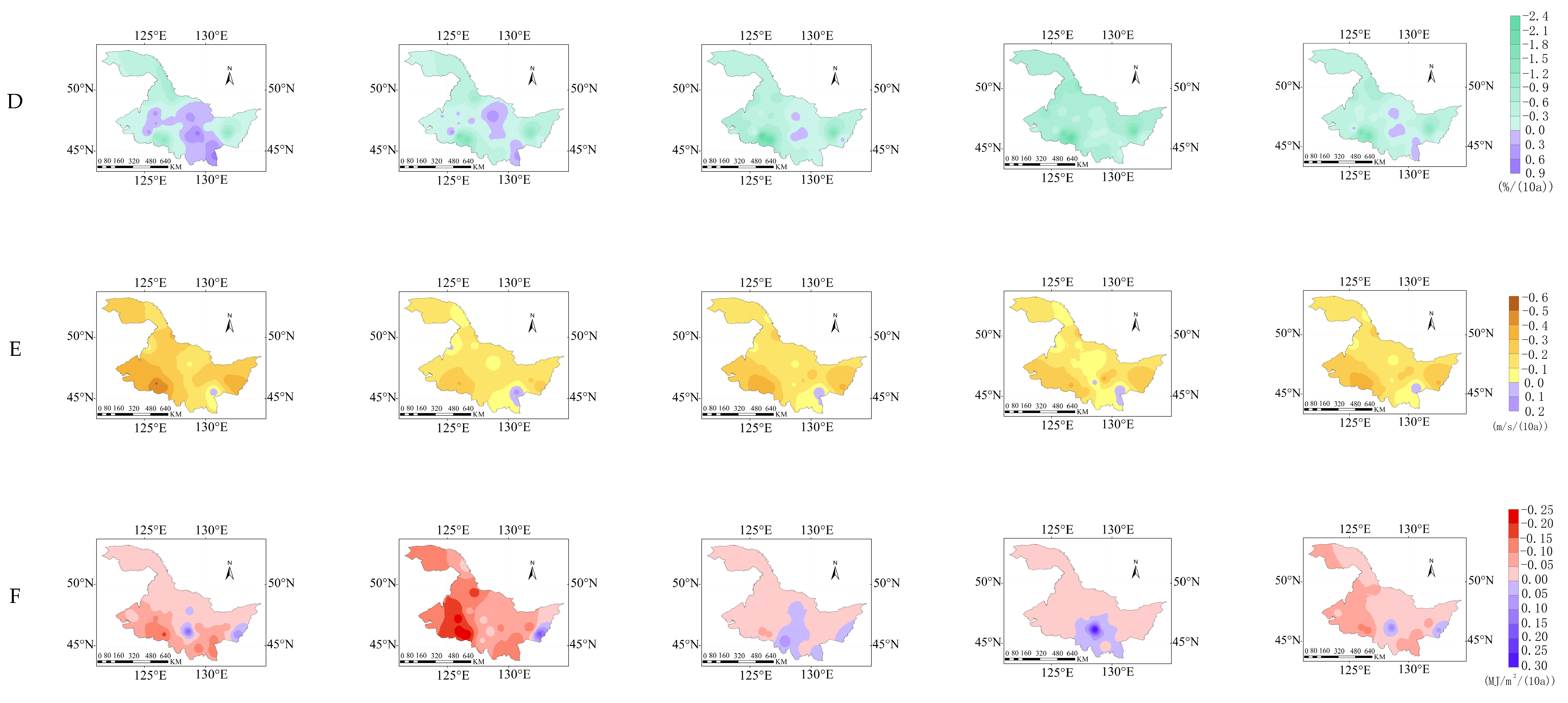

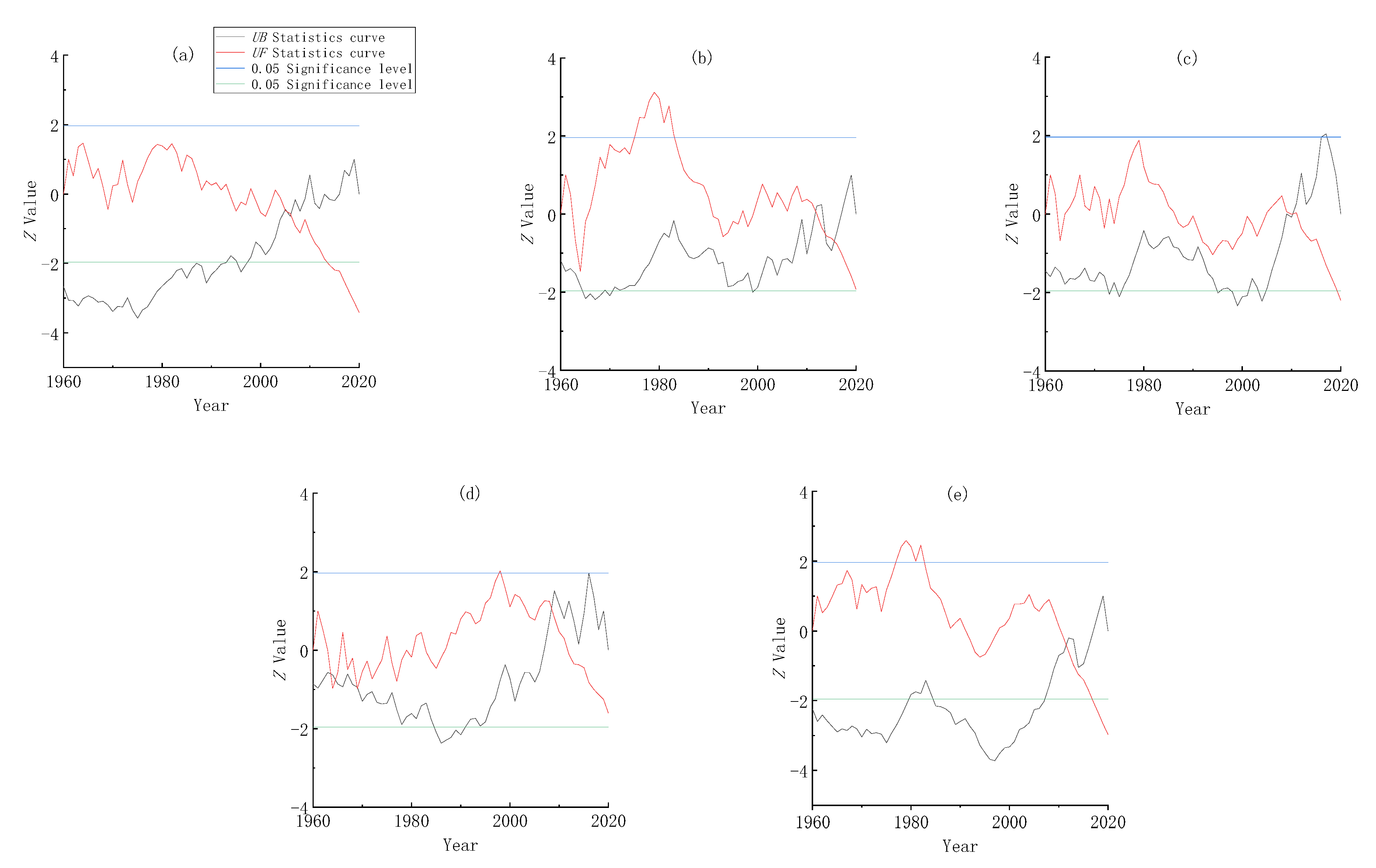
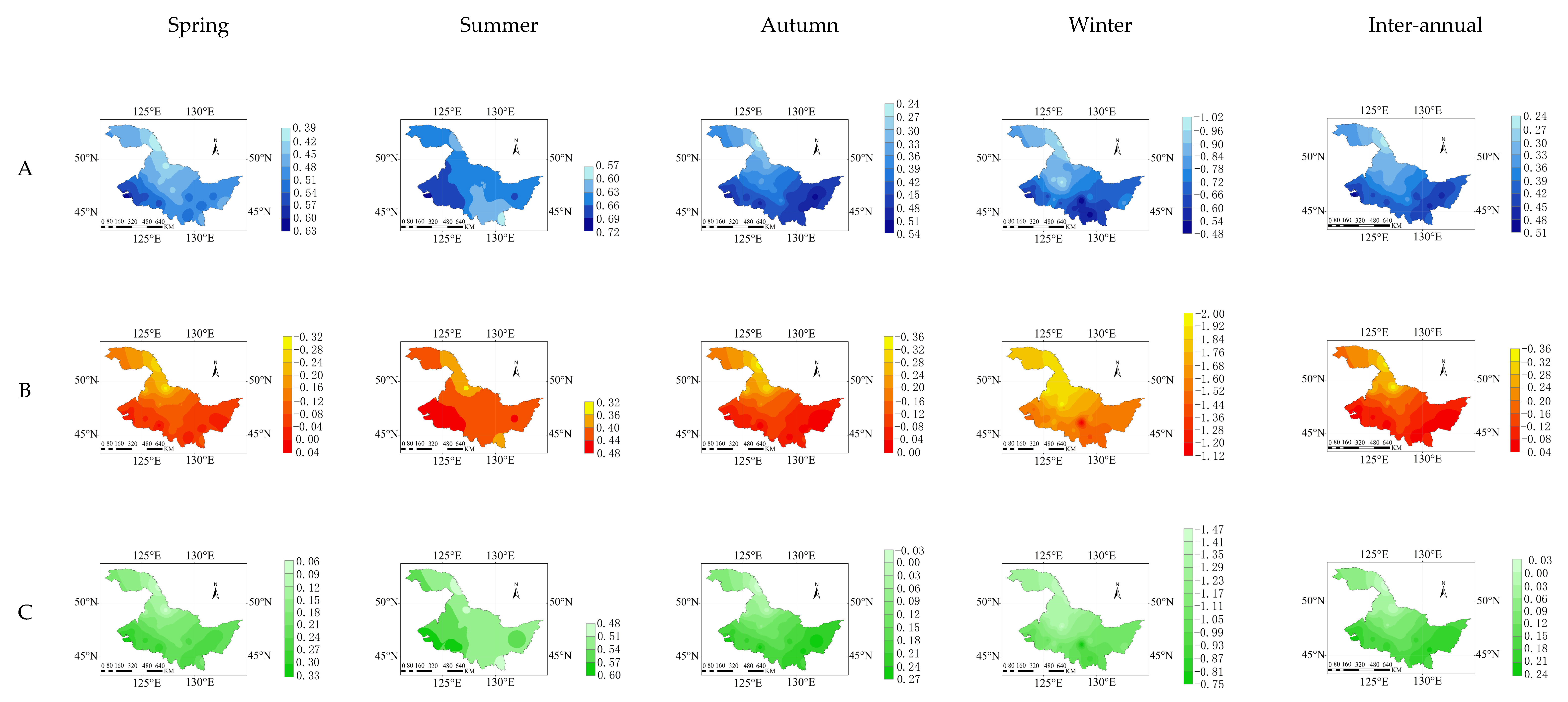
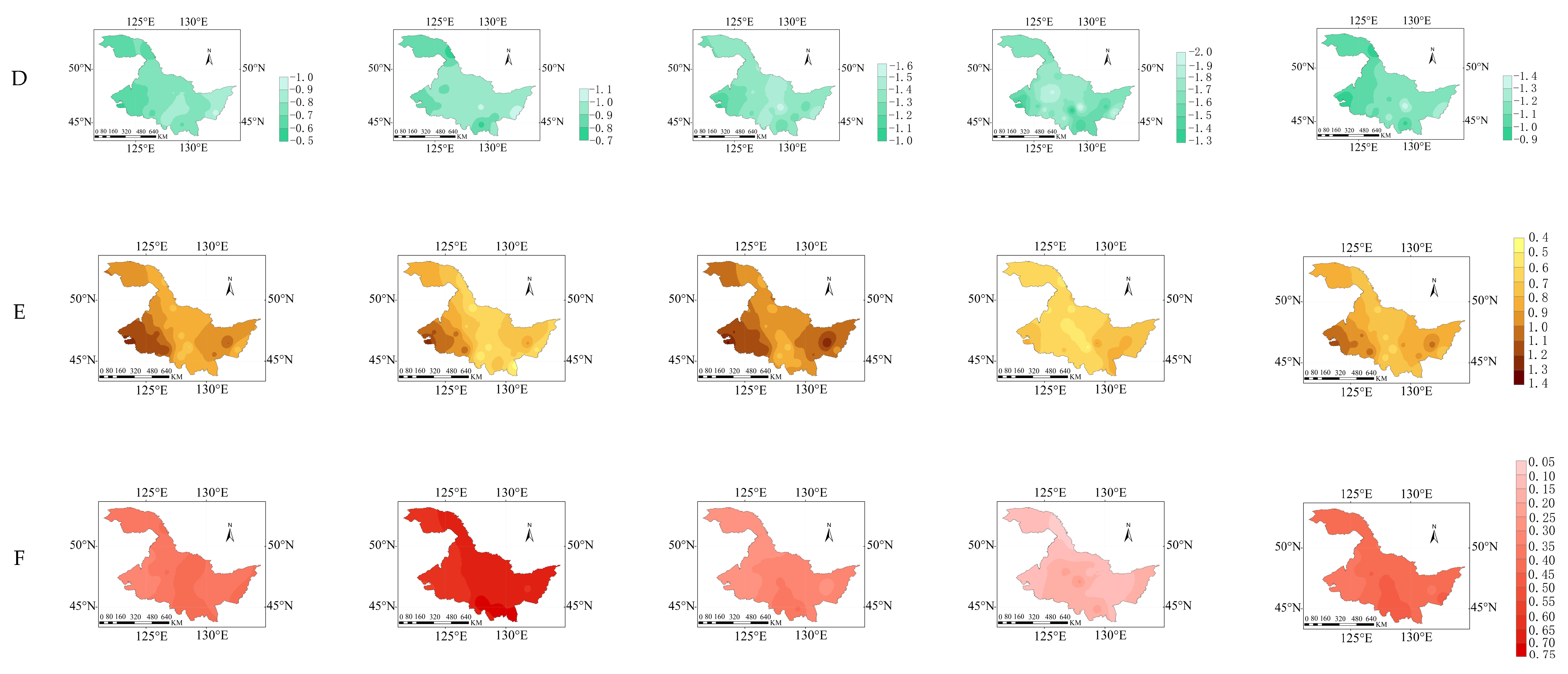
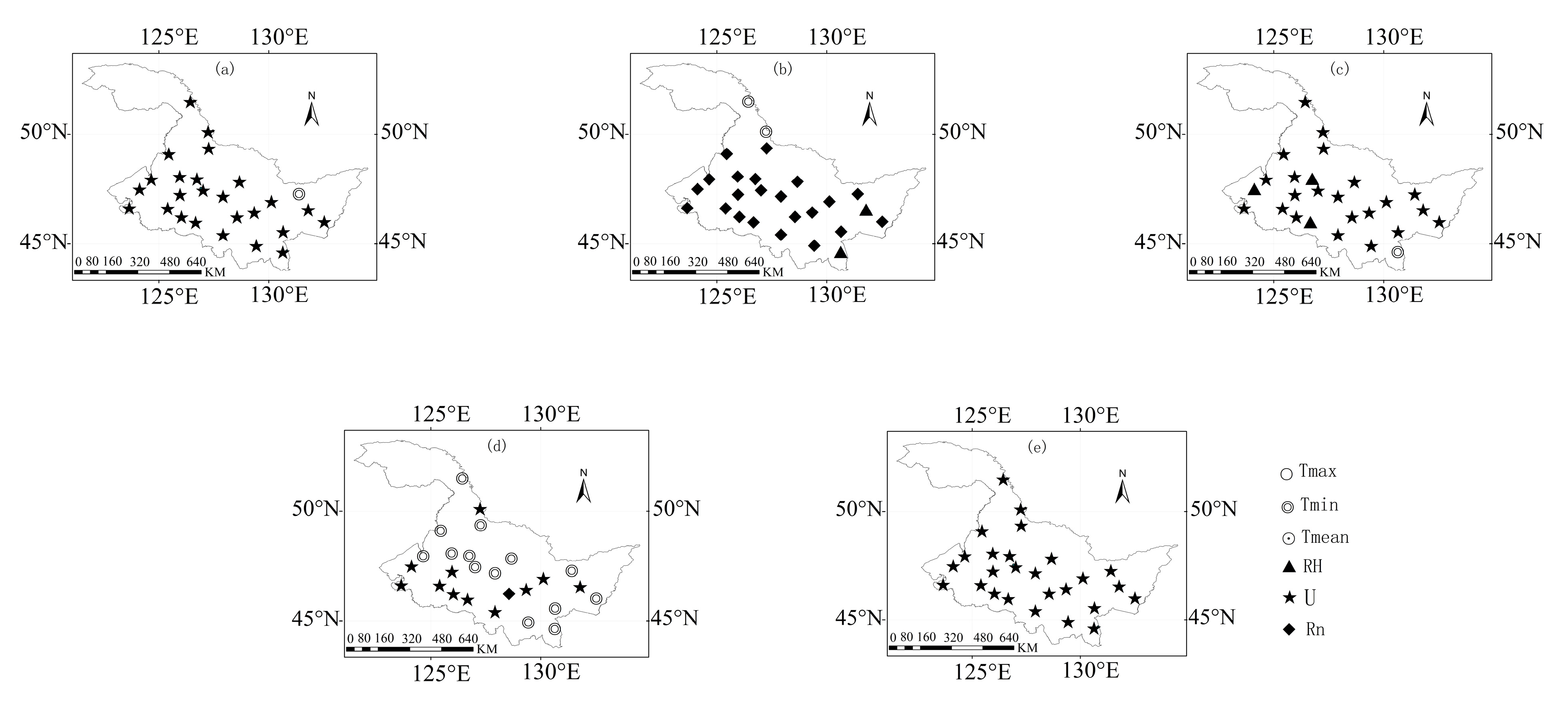
| Climatic Factors | Spring | Summer | Autumn | Winter | Inter-Annual |
|---|---|---|---|---|---|
| Tmax (°C/(10a)) | 0.25 * | 0.16 * | 0.19 * | 0.28 | 0.22 * |
| Tmin (°C/(10a)) | 0.57 * | 0.39 * | 0.43 * | 0.65 * | 0.49 * |
| Tmean (°C/(10a)) | 0.41 * | 0.26 * | 0.31 * | 0.47 * | 0.36 * |
| RH (%/(10a)) | −0.13 | −0.28 | −0.51 * | −0.78 * | −0.42 * |
| U (m/s/(10a)) | −0.24 * | −0.14 * | −0.18 | −0.15 * | −0.18 * |
| Rn (MJ/m2/(10a)) | −0.05 * | −0.10 * | −0.01 | −0.01 | −0.04 * |
| Season | U | Rn | RH | Tmax | Tmin | Tmean |
|---|---|---|---|---|---|---|
| Spring | 1.35 | 0.36 | −0.12 | 0.44 | −0.10 | 0.25 |
| Summer | 0.40 | 0.65 | −0.91 | 0.69 | 0.41 | 0.55 |
| Autumn | 1.40 | 0.28 | −1.34 | 0.39 | −0.14 | 0.15 |
| Winter | 0.53 | 0.10 | −1.67 | −1.64 | −1.76 | −1.32 |
| Inter-annual | 1.22 | 0.40 | −1.15 | 0.42 | −0.14 | 0.14 |
| Time Scales | Contribution Rates/% | Total Contribution/% | Dominant Factor | |||||
|---|---|---|---|---|---|---|---|---|
| U | Rn | RH | Tmax | Tmin | Tmean | |||
| Spring | −9.79 | −1.56 | 0.18 | 6.04 | −5.82 | 3.14 | −7.81 | U |
| Summer | −3.63 | −4.37 | 2.02 | 2.57 | 2.1 | 2.09 | 0.78 | Rn |
| Autumn | −13.14 | −0.3 | 7.33 | 4.7 | −4.5 | 3.78 | −2.13 | U |
| Winter | −10.86 | −0.3 | 3.09 | −10.1 | −11.46 | −9.33 | −38.96 | Tmin |
| Inter-annual | −8.96 | −2.82 | 3.34 | 5.15 | −1.41 | 4.03 | −0.67 | U |
Publisher’s Note: MDPI stays neutral with regard to jurisdictional claims in published maps and institutional affiliations. |
© 2022 by the authors. Licensee MDPI, Basel, Switzerland. This article is an open access article distributed under the terms and conditions of the Creative Commons Attribution (CC BY) license (https://creativecommons.org/licenses/by/4.0/).
Share and Cite
Nie, T.; Yuan, R.; Liao, S.; Zhang, Z.; Gong, Z.; Zhao, X.; Chen, P.; Li, T.; Lin, Y.; Du, C.; et al. Characteristics of Potential Evapotranspiration Changes and Its Climatic Causes in Heilongjiang Province from 1960 to 2019. Agriculture 2022, 12, 2017. https://doi.org/10.3390/agriculture12122017
Nie T, Yuan R, Liao S, Zhang Z, Gong Z, Zhao X, Chen P, Li T, Lin Y, Du C, et al. Characteristics of Potential Evapotranspiration Changes and Its Climatic Causes in Heilongjiang Province from 1960 to 2019. Agriculture. 2022; 12(12):2017. https://doi.org/10.3390/agriculture12122017
Chicago/Turabian StyleNie, Tangzhe, Rong Yuan, Sihan Liao, Zhongxue Zhang, Zhenping Gong, Xi Zhao, Peng Chen, Tiecheng Li, Yanyu Lin, Chong Du, and et al. 2022. "Characteristics of Potential Evapotranspiration Changes and Its Climatic Causes in Heilongjiang Province from 1960 to 2019" Agriculture 12, no. 12: 2017. https://doi.org/10.3390/agriculture12122017
APA StyleNie, T., Yuan, R., Liao, S., Zhang, Z., Gong, Z., Zhao, X., Chen, P., Li, T., Lin, Y., Du, C., Dai, C., & Jiang, H. (2022). Characteristics of Potential Evapotranspiration Changes and Its Climatic Causes in Heilongjiang Province from 1960 to 2019. Agriculture, 12(12), 2017. https://doi.org/10.3390/agriculture12122017








